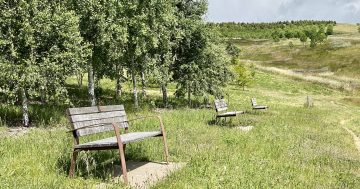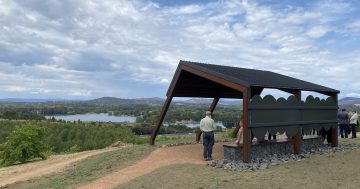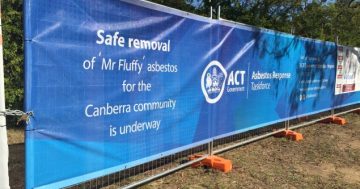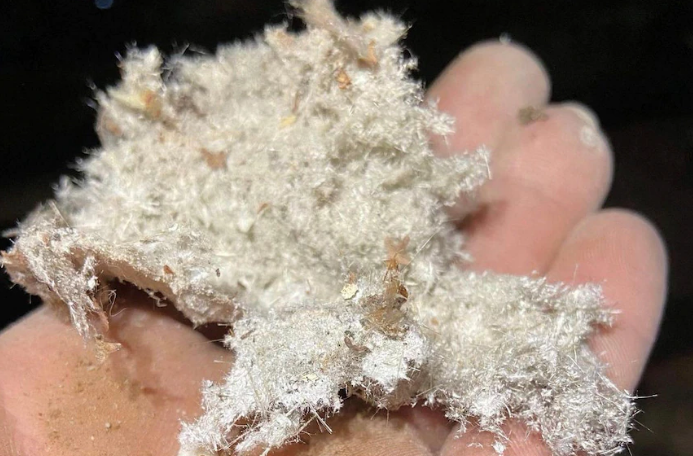
Asbestos fibres found in Dean Papas’s new Reid home. Photo: Supplied
Canberra builder Dean Papas is calling for mandatory asbestos inspections when properties are being sold after the purchase of his dream home turned into a nightmare with the discovery of deadly Mr Fluffy loose-fill asbestos in the ceiling.
Mr Papas was ecstatic when he bought the 1927 property in Reid at auction in May for $1.8 million, intending to renovate it.
With the seven-week renovation mostly complete, there was only a ceiling fan to be installed in the bathroom, requiring an electrician to cut a hole from the ceiling cavity.
It was then that the shocking discovery was made when the electrician pulled up layers of insulation to reveal suspicious white fibres.
He immediately contacted Mr Papas, who could not believe his ears.
“I said, ‘no way, I’ve been up there, it’s been inspected. It can’t be’,” he said.
But photos clearly showed what turned out to be loose-fill asbestos.
“My heart sank. I started feeling sick straight away,” Mr Papas said. “I knew when I saw the photo, that’s not great.”
The next day a sample was sent for analysis and came back positive.

The ceiling space of the Reid home where the loose-fill asbestos was found. Photo: Supplied.
Mr Papas advised the ACT Government’s Asbestos Taskforce, which set in train a now-familiar story.
Fortunately, the Papas family did not have to immediately vacate the property, with no actual contamination found inside, but the newly renovated house will have to be demolished and the site remediated.
After initial doubts, Mr Papas agreed to the buyback proposal and settled last Friday with the government. When the site is cleared, they will buy the block from the government and rebuild it from a clean slate sometime in 2022.
Mr Papas and his family are now renting.
Mr Papas said the renovation had not involved disturbance to the ceiling or walls, so he was not surprised that asbestos was not found in the house’s living space.
“I believe there has been worse than ours,” he said. “But it doesn’t really matter how much there is. Any amount that’s up there is not good for anyone down below. And it’s definitely not good for anyone who’s been in the ceiling cavity.”
Mr Papas said about 15 people who have been in the ceiling space, including himself, have potentially been exposed and will need to be screened.
“It’s worrying,” he said. “In the building industry, unfortunately, this is a risk that we take.
“I’ve seen a lot of asbestos. What we’re not exposed to is Mr Fluffy asbestos. That’s something that you thought would have been sorted by now.”
He believes that the asbestos fibres found in the ceiling are remnants left from an incomplete clean-up.
“It’s almost impossible to find until you get right further down into the ceiling cavity, which is where the bathroom was and where it was found,” Mr Papas said. “And that’s where you can start seeing deposits of it in large clumps.”
But it was missed during inspections done in the 80s and 90s of Mr Fluffy properties and during an extension in which the roof cavity was opened.
There are also no records of a Mr Fluffy contract or clean-up.
The Reid property is now the sixth to be found since the start of the government’s eradication scheme in 2014, but all six have been identified since the end of 2016, and Mr Papas believes there are more out there waiting to be found.
“A lot of people would be currently getting exposed without even knowing about it – both trades and homeowners,” he said.
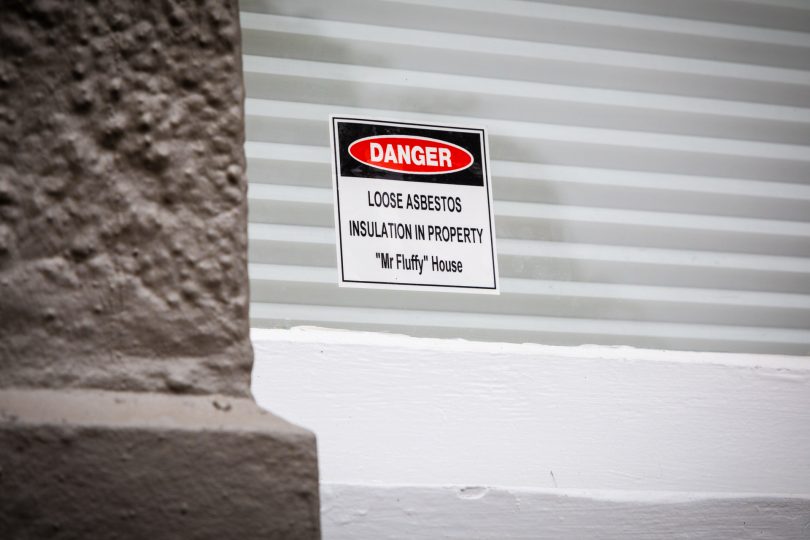
How many more Mr Fluffy asbestos houses are out there? Photo: Michelle Kroll.
That’s why he says the government should mandate inspections for any property built before 1980, as recommended by the Asbestos Taskforce in 2014 but not adopted.
Mr Papas said it would be just the same as a building report, with the $500 to $1000 cost payable by the purchaser at settlement.
“In the scheme of what’s going on in the market, where we’re paying with $1 million-plus for a house, what’s a $1000 for peace of mind?” he said
It would not cost the government any more money, and the one-time inspection would be on the building file forever.
But Sustainable Building and Construction Minister Rebecca Vassarotti believes the current mandatory asbestos awareness training for tradespeople has been effective in identifying the small number of homes that have been detected since its introduction in 2014.
“Prior to finalising the ACT’s new voluntary buyback program, which came into effect on 18 August 2021, the ACT Government reviewed the recommendations that informed the 2014 scheme, including a full asbestos assessment in the contract for sale for any home built before 1980,” she said.
But Mr Papas said that was just passing the risk to the building industry.
“That’s crazy to me: let’s just let contractors and builders go in there and let them find it and be exposed,” he said.
“It makes me really, really angry as a builder who grew up in Canberra that this hasn’t been sorted.
“If we can try and create some movement to get some changes put in place to not have this happen to people like us or anyone moving forward, that’ll be a good thing.”
The government says prospective buyers in the ACT can request a comprehensive asbestos assessment of the property before purchase or auction and ask that it form part of the contract of sale.
It recommends an asbestos assessment for a residential property built or started being built before 1985 if the buyer has any concerns regarding the property.












